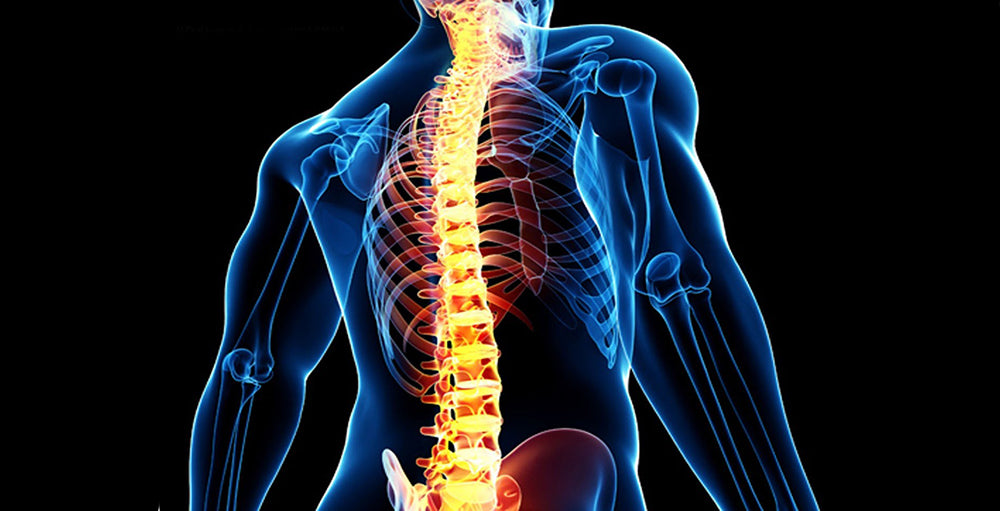Considered the supporting structure of the whole skeleton, the vertebral column is made up of vertebrae resting on each other and interspersed with intervertebral discs.
It represents the posterior support of the back from which the ribs start, gathered anteriorly at the level of the sternum, which make up the rib cage.
The spine (rachis) is divided into five parts, which are:
- cervical (7 vertebrae);
- thoracic (12 vertebrae);
- lumbar (5 vertebrae);
- sacral (5 vertebrae);
- coccygeal (4 vertebrae).
Its function is to contain the spinal cord, a section of the nervous system made up of nerve fibers that control the functioning of the entire body; it carries out the very important task of connecting the brain (which is located in the skull) with all organs.
The spine is not a fixed structure as the vertebrae are equipped with the ability to move, even if limited, between them, absorbing friction through the intervertebral discs whose role is precisely to make the movements harmonious.
Another fundamental function performed by the rachis is then to support both the skeleton in every part, and the skull, to allow people to maintain balance and move.
Thanks to the presence of the two anatomical curves (lordosis and kyphosis), the spine is endowed with considerable elasticity and resistance, responsible for its regulatory function on all the activities of the body.
In fact, respiration, renal filtration, cardio-circulatory function and digestion can take place because the affected organs are protected by the skeletal bone structures, which are precisely supported by the rachis.
It can therefore be said that the spine functions as a semi-mobile chain, articulated and taut capable of absorbing shocks and at the same time favoring the movement of the upper (arms) and lower (legs) limbs.
THE IDEAL BED FOR BACK PAIN
Most spinal disorders it depends on an incorrect position that can be assumed by the vertebrae, often as a result of postural defects.
In fact, when the back does not maintain an anatomical posture, the intervertebral discs tend to alter the connections between the vertebrae; consequently the spinal cord contained in them can undergo a compression causing pain.
The main types of vertebral disorders are all characterized by pain and are commonly referred to as "back pain"; in reality painful sensations are not a disease, but a symptom.
Protrusions of the back of the disc usually occur, responsible for inflammatory syndromes at the affected nerve endings which, depending on the anatomical portion, trigger a morbid picture that takes the name of:
- stiff neck (neck pain)
when the problem occurs at the level of the cervical vertebrae and concerns localized pain in the neck and shoulders which often also radiates to the arms;
- sciatica
when the disorder concerns the underlying vertebral portion (thoracic) and manifests itself with the typical high back pain, responsible for pain during breathing and in the transition from lying to standing position;
- low back pain
when the discomfort involves the last sections of the rachis (lumbar and sacral) and the subject experiences painful symptoms in the lower back, involving the legs, which becomes acute during any movement.
In addition to these rather common pathologies, another disease attributable to the incorrect functioning of the spine is the herniated disc, consisting in the leakage of a small portion of the spinal cord at the level of an intervertebral space.
In this case, crushing of nerve structures occurs which cause the onset of acute pain, tingling in the limbs and often motor difficulties.
Importance of rest for the spine
For the spine to stay healthy its anatomical structures (vertebrae and intervertebral discs) must maintain a correct position, without postural anomalies.
For this purpose, the position that the body assumes during the night's rest is of fundamental importance, when it is in a horizontal position and therefore is subjected to the force of gravity that is exerted on the whole spine.
In addition, the muscles relax during the night as it is not stimulated to make any movement and therefore tends to assume a position conditioned by the structure on which it rests, consisting of the mattress and the network.
The bed base-mattress system therefore plays an extremely important role to keep the spine in correct position during the phase in which the muscles cannot control it as they are relaxed.
Therefore it is always advisable to opt for an orthopedic base, capable of supporting the body following its anatomy.
Even more important is the choice of the mattress, which must be able to accommodate the body structure while maintaining its curves; it is in fact necessary that the vertebral column is kept on axis without taking wrong positions that could trigger disorders of various kinds.
The latest generation mattresses allow an ideal and targeted housing to the different parts of the body, supporting more the thoracic and lumbar portion of the spine to prevent the anatomical curvatures from changing.
Also in the cervical area the mattress must support this delicate part of the skeleton, ensuring that upon awakening the subject does not feel the annoying sensation of a stiff neck.
In addition, the best mattresses available on the market are able to ensure proper transpiration of the body, to ensure the essential thermal homeostasis for sleeping well.

